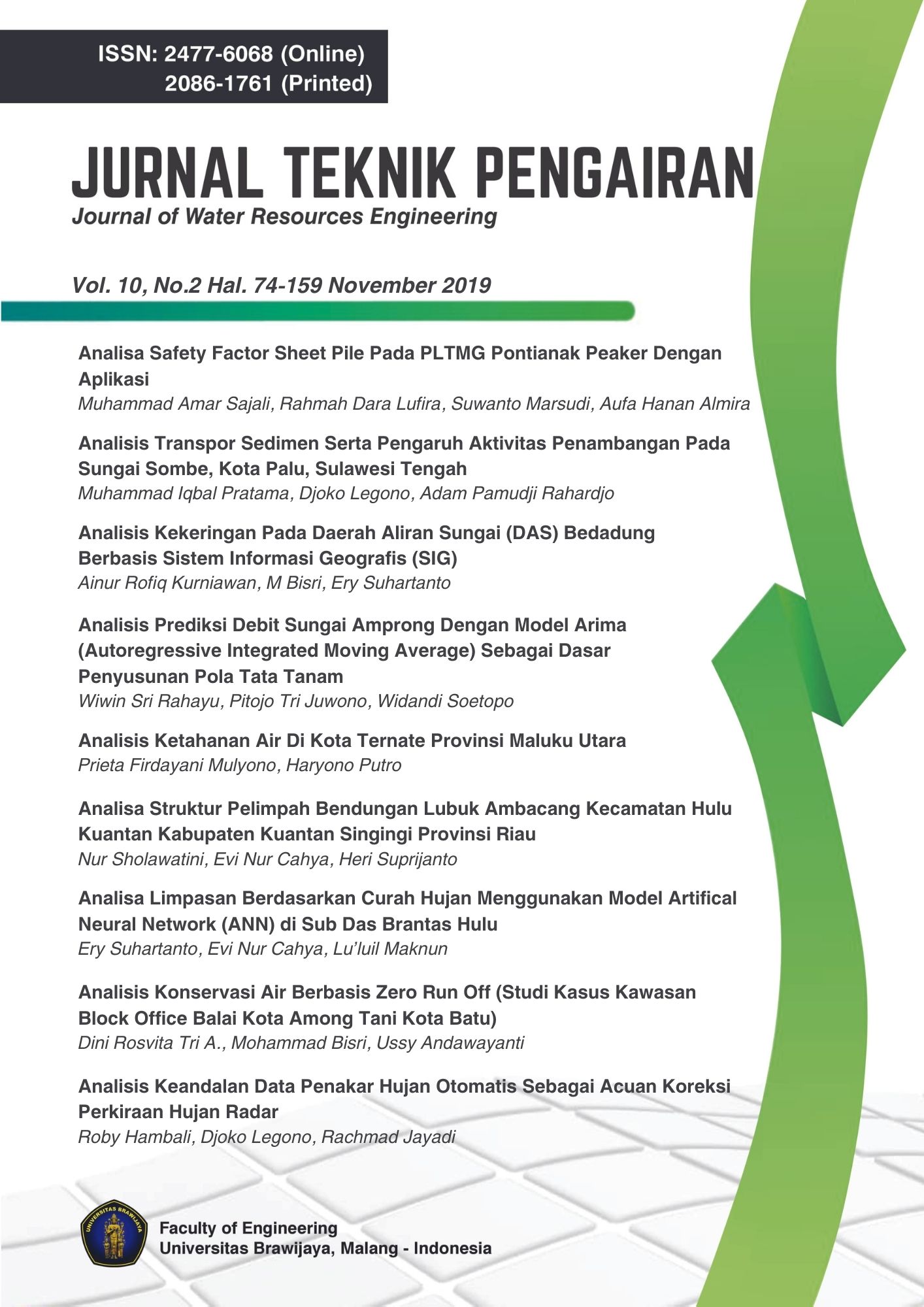Analisa Limpasan Berdasarkan Curah Hujan Menggunakan Model Artifical Neural Network (ANN) di Sub Das Brantas Hulu
DOI:
https://doi.org/10.21776/ub.pengairan.2019.010.02.07Keywords:
discharge, artifical neural network (ANN), nash sutchlife efficient test (NSE), correlation coefficient (R)Abstract
Discharge data is usually less available than rainfall data, so it is necessary to find a relationship between river flows that are applied in the period available rainfall data in a watershed area. The purpose of this study is to determine the suitability of the method based on the analysis of data validation between the observed discharge and the model discharge. The method is done by modeling the discharge based on rainfall with the Artificial Neural Network (ANN) MATLAB R2014b program. The Upper Brantas Watershed is used as a case study because it often has runoff problems. Validation of the ANN method was tested with Root Mean Square Error (RMSE), Nash-Sutcliffe Efficiency (NSE), Correlation Coefficient (R) and Relative Error (KR). From the results of calibration using the ANN Model, the best data is found in the five years data of epoch 500. Verification results based on the value of R have a relatively good relationship between observation discharges with model discharges. The validation results show the validity in a year data of epoch 500.References
Dharma, Sila., Putera, Andyana., Ardana, Putu D H. (2011). Artificial Neural Network Untuk Pemodelan Curah Hujan-Limpasan Pada Daerah Aliran Sungai (DAS) Di Pulau Bali. Jurnal Bumi Lestari. Vol 11 (I). 9-22.
Harto, Sri. (1990). Analisis Hidrologi. Yogyakarta: Universitas Gadjah Mada.
Indarto. (2012). Hidrologi Dasar Teori dan Contoh Aplikasi Model Hidrologi. Jakarta: PT Bumi Aksara.
Kusumadewi, Sri. (2003). Artifical Intelligence (Teknik dan Aplikasinya). Yogyakarta: PT Graha Ilmu
Motovilov, Y.G., Gottschalk, L., Engeland, K. & Rodhe, A. (1999). Validation of a Distributed Hydrological Modelling Against Spatial Observations. Elseiver Agricultural and Forest Meteorology. 98 : 257 – 277
Sakinah, Rahimatus; Sulistiyono, Heri; Budianto, M. Bagus. (2015). Aplikasi Metode MOCK, NRECA, Artificial Neural Network, Dan Regresi Dalam Pengalihragaman Hujan-Limpasan Terkait Dengan Pembangkitan data Debit Di AWLR Matua. Jurnal Mahasiswa Jurusan Teknik Sipil. 1-12
Siang, J. (2005). Jaringan Syaraf Tiruan dan Pemrogramannya menggunakan Matlab. Yogyakarta: Andi.
Soemarto, CD. (1999). Hidrologi Teknik. Edisi 2. Jakarta: Erlangga.
Soewarno. (1995). Hidrologi Aplikasi Metode Statistik untuk Analisa Data Jilid 2. Bandung: NOVA.
Sugiyono. (2007). Statistika Untuk Penelitian. Bandung: CV. ALFABETA
Suhardi; Sulaksono, Heri Budi; Halik, Gusfan. (2017). Aplikasi jaringan Syaraf Tiruan (JST) Untuk Analisa Debit DAS Bedadung Di Kabupaten Jember. Jurnal Konferensi Nasional Teknik Sipil dan Infrastruktur, Vol I, 35-43.
Triatmodjo, B. (2006). Hidrologi Terapan. Yogyakarta: Beta Offset.
Widyastuti, Siska; Suhartanto, Ery; Dermawan, Very. (2016). Analisa Hujan-Limpasan Menggunakan Model Artifical Neural Network (ANN) Di Sub DAS Lesti. Skripsi. Tidak dipublikasikan. Malang: Universitas Brawijaya.
Yatmadi, Denny; Prihutomo, Nuzul B. (2014). Perbandingan Model Curah Hujan Limpasan antara Metode Jaringan Syaraf Tiruan dengan Metode Sacramento. Jurnal Politeknologi, Vol 13 (1), 41-42.
Downloads
Published
How to Cite
Issue
Section
License
Copyright (c) 2019 Ery Suhartanto, Evi Nur Cahya, Lu'luil Maknun

This work is licensed under a Creative Commons Attribution-NonCommercial 4.0 International License.
Authors who publish with this journal agree to the following terms:
Authors retain copyright and grant the journal right of first publication with the work simultaneously licensed under a Creative Commons Attribution-NonCommercial 4.0 International License that allows others to share the work with an acknowledgement of the work's authorship and initial publication in this journal.
Authors are able to enter into separate, additional contractual arrangements for the non-exclusive distribution of the journal's published version of the work (e.g., post it to an institutional repository or publish it in a book), with an acknowledgement of its initial publication in this journal.
Authors are permitted and encouraged to post their work online (e.g., in institutional repositories or on their website) prior to and during the submission process, as it can lead to productive exchanges, as well as earlier and greater citation of published work (See The Effect of Open Access).




2.png)









